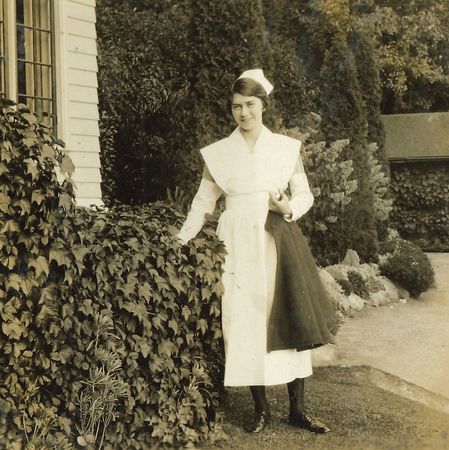
 604 465 4322
604 465 4322General Store Site 12294 Harris Road Pitt Meadows, B.C.
Click Here for Directions& Visiting Hours

Looking Back: A Timely Document from the District of Pitt Meadows Collection
Looking back article from February 2022
*The image features a young nurse, Winnifred Mole (nee: Challenger) c. 1930s.
In recent news unvaccinated truck drivers blocked the entrance into Canada at the Ambassador Bridge to protest vaccination, covid-testing and quarantine. The health and safety of the public is the joint responsibility of citizens and their government. Both Canadians and their elected officials have agency to affect the collectives’ recovery from a pandemic through their actions. The government’s handling of the pandemic mirrors its efforts during the Influenza outbreak a century ago.
On October 8, 1918, J.S. Maclear (Provincial Secretary) sends a telegram to the Pitt Meadows Council. It states that “the Provincial Board of Health has proclaimed regulations empowering all municipalities close all schools, churches, theatres and other public meetings to prevent the spread of Spanish Influenza. Please confer with your local board of health and advise me at once as to conditions [there] and as to the necessity of putting these regulations into effect in your municipality. Victoria has already taken such action.” The Provincial Board of Health gave municipalities throughout B.C. the power to close public meeting places to minimize the pervasiveness of the flu.
The devastating affects of the flu led to enforced shutdowns in Victoria. This telegram shows the order of power from the Provincial Board of Health to municipalities. If there is resistance from locals, then the municipality can seek support from the Provincial government to fulfill closures. The Provincial Secretary asks the municipal council to consult with the local board of health, report what the conditions are like in Pitt Meadows and if it is necessary to close public meeting places. But Pitt Meadows never had a Board of Health. This responsibility would have been handled by the municipal council. The Museum does not have a record of council’s report. Neither does it have proof of closure for schools, the church or the General Store. It is likely that the council did not close these places of meeting. Nevertheless, Pitt Meadows’ residents did not escape the harmful effects of the flu. The influenza virus killed 40 of 260 Katzie and one pioneer, Jim McMyn, in this community. Other Pitt Meadows’ residents that suffered from influenza sought medical attention at the nearest hospital which was in New Westminster. Flu cases would be recorded at the hospital and that information, as far as we know, was not sent to the municipality.
There are similarities between the provincial government’s handling of the pandemics in 1918 and a century later. Both Provincial Boards of Health in 1918 and in 2020 disseminated the order to close places of public meetings. The result of the 1918 pandemic was the establishment of the Federal Department of Health in 1919. This department made public health a shared responsibility among all levels of government. Resistance to the government’s mandate today shows that the health of the public can not easily be accomplished without the cooperation of citizens to follow regulations.
Rebekah Abebe, Pitt Meadows Museum and Archives





